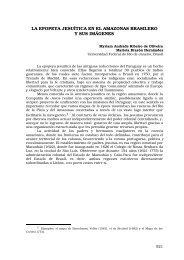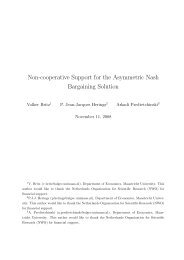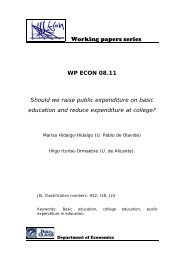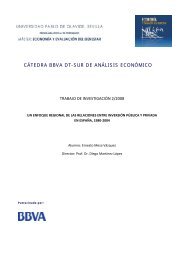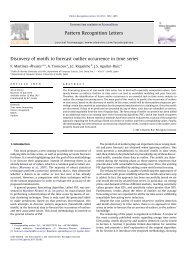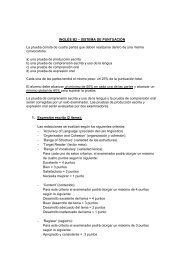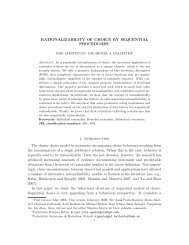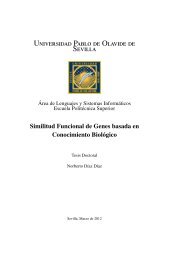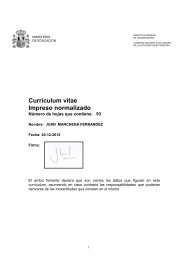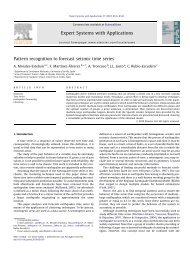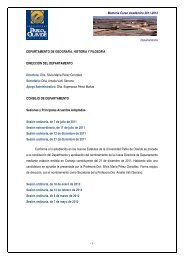Calculation of Volatility in a Jump-Diffusion Model
Calculation of Volatility in a Jump-Diffusion Model
Calculation of Volatility in a Jump-Diffusion Model
You also want an ePaper? Increase the reach of your titles
YUMPU automatically turns print PDFs into web optimized ePapers that Google loves.
<strong>Calculation</strong> <strong>of</strong> <strong>Volatility</strong> <strong>in</strong> a <strong>Jump</strong>-<strong>Diffusion</strong> <strong>Model</strong><br />
Javier F. Navas 1<br />
This Draft: October 27, 2003<br />
Forthcom<strong>in</strong>g: The Journal <strong>of</strong> Derivatives<br />
JEL Classification: G13<br />
Keywords: jump-diffusion process, option pric<strong>in</strong>g, volatility smile<br />
1 Instituto de Empresa, Maria de Mol<strong>in</strong>a 13, Madrid 28006, Spa<strong>in</strong>. Phone: +34 91 568-9600.<br />
Fax: +34 91 563-6859. E-mail: jfnavas@ie.edu. I would like to thank John J. McConnell,<br />
Stephen Figlewski (the editor), and an anonymous referee for their helpful comments and<br />
sugestions. The usual caveat applies.
Abstract<br />
A common way to <strong>in</strong>corporate discont<strong>in</strong>uities <strong>in</strong> asset returns is to add a Poisson process<br />
to a Brownian motion. The jump-diffusion process provides probability distributions<br />
that typically fit market data better than those <strong>of</strong> the simple diffusion process. To<br />
compare the performance <strong>of</strong> these models <strong>in</strong> option pric<strong>in</strong>g, the total volatility <strong>of</strong> the<br />
jump-diffusion process must be used <strong>in</strong> the Black-Scholes formula. A number <strong>of</strong> authors,<br />
<strong>in</strong>clud<strong>in</strong>g Merton (1976a & b), Ball and Torous (1985), Jorion (1988), and Am<strong>in</strong> (1993),<br />
miscalculate this volatility because they do not <strong>in</strong>clude the effect <strong>of</strong> uncerta<strong>in</strong>ty over the<br />
jump size. We calculate the volatility correctly and show how this affects option prices.<br />
JEL Classification: G13<br />
Keywords: jump-diffusion process, option pric<strong>in</strong>g, volatility smile<br />
1
The diffusion process is widely used to describe the evolution <strong>of</strong> asset returns over<br />
time. In option pric<strong>in</strong>g it allows the use <strong>of</strong> Black and Scholes-type formulae to value<br />
European options on stocks, foreign currencies, <strong>in</strong>terest rates, commodities and futures.<br />
Under this process, <strong>in</strong>stantaneous asset returns are normally distributed. However, the<br />
distributions observed <strong>in</strong> the market exhibit non-zero skewness and higher kurtosis than<br />
the normal distribution 1 , which produces pric<strong>in</strong>g errors when the Black-Scholes formula<br />
is used.<br />
A way <strong>of</strong> obta<strong>in</strong><strong>in</strong>g distributions consistent with market data is to assume that the<br />
stock price follows a jump-diffusion process. Merton (1976a) develops a model <strong>in</strong> which<br />
the arrival <strong>of</strong> normal <strong>in</strong>formation is modeled as a diffusion process, while the arrival<br />
<strong>of</strong> abnormal <strong>in</strong>formation is modeled as a Poisson process. The jump-diffusion process<br />
can potentially describe stock prices more accurately at the cost <strong>of</strong> mak<strong>in</strong>g the market<br />
<strong>in</strong>complete, s<strong>in</strong>ce jumps <strong>in</strong> the stock price cannot be hedged us<strong>in</strong>g traded securities. If<br />
the market is <strong>in</strong>complete, the pay<strong>of</strong>fs <strong>of</strong> the option cannot be replicated, and the option<br />
cannot be priced. To overcome this problem, Merton assumes that the jump risk is<br />
diversifiable and, consequently, not priced <strong>in</strong> equilibrium. He then derives a closed-form<br />
expression for the price <strong>of</strong> a call option.<br />
To study the performance <strong>of</strong> the jump-diffusion model, Merton (1976b) compares op-<br />
tion prices computed with his model with those obta<strong>in</strong>ed with the Black-Scholes formula.<br />
For this comparison to be mean<strong>in</strong>gful, the total volatility <strong>of</strong> the jump-diffusion process<br />
(ν) must be used <strong>in</strong> the Black-Scholes formula. Merton (1976a & b) miscalculates this<br />
volatility because he leaves out the effect <strong>of</strong> jump size uncerta<strong>in</strong>ty on return volatility,<br />
so his measure is smaller than ν. We refer to this measure as “Merton’s volatility rate”<br />
(νM). He f<strong>in</strong>ds that there can be significant differences <strong>in</strong> option prices for deep out-<br />
<strong>of</strong>-the-money options and short maturity options when there are large and <strong>in</strong>frequent<br />
1 See, for example, Fama (1965), Jorion (1988), Hsieh (1988), Bates (1996), and Campa et al. (1997).<br />
2
jumps.<br />
Ball and Torous (1985) analyze a sample <strong>of</strong> NYSE listed common stocks and f<strong>in</strong>d the<br />
existence <strong>of</strong> lognormal jumps <strong>in</strong> most <strong>of</strong> the daily returns considered. They then study<br />
Merton and Black-Scholes call option prices and f<strong>in</strong>d small differences. However, they<br />
also miscalculate the total volatility <strong>of</strong> the jump-diffusion process, so that their results<br />
should be <strong>in</strong>terpreted with care.<br />
Other examples where the volatility <strong>of</strong> the jump-diffusion process is computed <strong>in</strong>cor-<br />
rectly are Jorion (1988), who adapts Merton’s model to price foreign currency options,<br />
and Am<strong>in</strong> (1993), who develops a discrete-time option pric<strong>in</strong>g model under a jump-<br />
diffusion process.<br />
In this note we compute the total volatility <strong>of</strong> the jump-diffusion process correctly<br />
and show the effect <strong>of</strong> the miscalculation on option prices. We f<strong>in</strong>d that that the pric<strong>in</strong>g<br />
error can be larger or smaller that what was previously reported, and that some options<br />
undervalued with νM are <strong>in</strong> fact overvalued with the correct volatility measure.<br />
The rest <strong>of</strong> the paper is organized as follows. Next section briefly reviews the Merton<br />
(1976a) model and presents the total variance <strong>of</strong> the jump-diffusion process. Us<strong>in</strong>g this<br />
variance, we study <strong>in</strong> Section 2 the pric<strong>in</strong>g error <strong>of</strong> an <strong>in</strong>vestor who uses the Black-<br />
Scholes formula to price options when the stock price follows a jump-diffusion process.<br />
F<strong>in</strong>ally, we conclude with Section 3.<br />
1 Merton’s <strong>Jump</strong>-<strong>Diffusion</strong> Formula<br />
We consider a cont<strong>in</strong>uous trad<strong>in</strong>g economy with trad<strong>in</strong>g <strong>in</strong>terval [0, τ] for a fixed τ > 0, <strong>in</strong><br />
which there are three sources <strong>of</strong> uncerta<strong>in</strong>ty, represented by a standard Brownian motion<br />
{Z(t) : t ∈ [0, τ]} and a <strong>in</strong>dependent Poisson process {N(t) : t ∈ [0, τ]} with constant<br />
<strong>in</strong>tensity λ and random jump size Y on the filtered probability space (Ω, F, Q, {Ft : t ∈<br />
3
[0, τ]}).<br />
We def<strong>in</strong>e Ft ≡ F Z t ∨ F N t and F ≡ Fτ, where F Z t and F N t are the smallest right-<br />
cont<strong>in</strong>uous complete σ-algebras generated by {Z(s) : s ≤ t} and {N(s) : s ≤ t} respec-<br />
tively.<br />
Merton (1976a) assumes that the stock price dynamics are described by the follow<strong>in</strong>g<br />
stochastic differential equation<br />
dS(t)<br />
S(t−)<br />
= (α − λκ) dt + σdZ(t) + (Y (t) − 1)dN(t), (1)<br />
where κ ≡ E {Y (t) − 1} is the expected relative jump <strong>of</strong> S(t).<br />
Assum<strong>in</strong>g that jump sizes are lognormally distributed with parameters µ and δ, and<br />
that the jump risk is diversifiable, Merton shows that the option price is given by<br />
F(S(t), τ, K, σ 2 , r; µ, δ 2 ∞� e<br />
, λ) =<br />
n=0<br />
−λ′ τ ′ n (λ τ)<br />
W(S(t), τ, K, σ<br />
n!<br />
2 n , rn) (2)<br />
where W(S(t), τ, K, σ 2 n, rn) is the Black-Scholes option price for a European option with<br />
exercise price K and maturity τ on a non-dividend stock. The volatility <strong>of</strong> stock returns<br />
is σ, the risk-free <strong>in</strong>terest rate is r, and<br />
rn ≡ r + n<br />
τ<br />
�<br />
σ 2 n ≡ σ2 + n<br />
τ δ2 ,<br />
µ + δ2<br />
2<br />
�<br />
λ ′ ≡ λ(1 + κ) = λexp<br />
− λκ,<br />
�<br />
µ + δ2<br />
2<br />
Unlike <strong>in</strong> the diffusion case, when changes <strong>in</strong> stock prices are given by expression (1)<br />
the <strong>in</strong>stantaneous stock returns are not normally distributed. The distribution will<br />
have non-zero skewness and will exhibit leptokurtosis when compared to a Gaussian<br />
4<br />
�<br />
.
distribution, which is consistent with the empirical evidence. There will not be, <strong>in</strong><br />
general, a closed-form expression for the density function <strong>of</strong> the distribution, but we can<br />
easily compute the moments <strong>of</strong> stock returns. Apply<strong>in</strong>g Itô’s formula to (1) we have<br />
that, under Q, the expected natural logarithm <strong>of</strong> the stock price is given by<br />
�<br />
E ln S(t)<br />
�<br />
S(0)<br />
=<br />
=<br />
=<br />
�<br />
α − λκ − σ2<br />
�<br />
t + E<br />
2<br />
�<br />
E �<br />
lnY(n(t))|F N ��<br />
T<br />
�<br />
α − λκ − σ2<br />
�<br />
t + E {n(t)µ} ,<br />
2<br />
�<br />
α − λκ − σ2<br />
�<br />
t + λtµ,<br />
2<br />
where Y (n) ≡ � n i=1 Yi, {Yi, i = 1, 2, . . ., n} are the random jump amplitudes, and n(t) is<br />
a Poisson random variable with parameter λt.<br />
S<strong>in</strong>ce the Brownian motion and the Poisson process are <strong>in</strong>dependent by construction<br />
(see Protter (1995)), to calculate the variance, we can write<br />
�<br />
V ar ln S(t)<br />
�<br />
= V ar {σZ(t)} + V ar {lnY(n(t))} (3)<br />
S(0)<br />
Notice that � n i=1 lnYi is conditionally distributed as a Gaussian with mean nµ and<br />
variance nδ 2 . However, this does not imply that V ar {lnY(n(t))} = λtδ 2 s<strong>in</strong>ce now n(t)<br />
is random. Us<strong>in</strong>g the fact that for any random variable u, V ar{u} = −E{u} 2 + E {u 2 }<br />
we have that<br />
V ar {lnY(n(t))} = −E {lnY(n(t))} 2 + E �<br />
[lnY(n(t))] 2�<br />
= −(λtµ) 2 + E �<br />
E �<br />
[lnY(n(t))] 2 |F N ��<br />
T<br />
= −(λtµ) 2 + E �<br />
n(t)δ 2 + n(t) 2 µ 2�<br />
= −(λtµ) 2 + δ 2 �<br />
2<br />
λt + µ λt + λ 2 t 2�<br />
5
= λ �<br />
µ 2 + δ 2�<br />
t. (4)<br />
Hence, the total variance <strong>of</strong> the natural logarithm <strong>of</strong> the stock price under a jump-<br />
diffusion process is given by<br />
�<br />
V ar ln S(t)<br />
�<br />
S(0)<br />
= �<br />
σ 2 + λ �<br />
µ 2 + δ 2��<br />
t. (5)<br />
A similar result can be found <strong>in</strong> Press (1967), Navas (1994), and Das and Sundaram<br />
(1999). Merton (1976a & b), Ball and Torous (1985), Jorion (1988), and Am<strong>in</strong> (1993)<br />
miscalculate this variance as (σ 2 +λδ 2 )t, which will only be correct when µ = 0. However,<br />
they assume that the expected jump size is zero, i.e. E{Y − 1} = 0, which is equivalent<br />
to take µ = − δ2<br />
2 . Obviously, when δ2 <strong>in</strong>creases the error <strong>in</strong> the variance will <strong>in</strong>crease.<br />
2 Implications for Option Pric<strong>in</strong>g<br />
If an <strong>in</strong>vestor prices options accord<strong>in</strong>g to the Black-Scholes model but the market prices<br />
options accord<strong>in</strong>g to Merton’s jump-diffusion process, she will underprice out-<strong>of</strong>-the-<br />
money and <strong>in</strong>-the-money options and she will overprice at-the-money (ATM) options,<br />
s<strong>in</strong>ce the true stock return distribution will have fatter tails than the Gaussian distrib-<br />
ution. Hence, if the <strong>in</strong>vestor estimates the volatility parameter <strong>of</strong> the diffusion process<br />
implicitly from market prices, she will observe the well known volatility smile. In Fig-<br />
ure 1 we price a call option with different exercise prices with Merton’s (1976a) model<br />
us<strong>in</strong>g the parameters τ = 0.5, σ 2 = 0.05, r = 0.10, µ = −0.025, δ 2 = 0.05, and λ = 1.<br />
Then, we take those values as market prices and compute implied volatilities from the<br />
Black-Scholes formula. We observe that <strong>in</strong> order to fit “market” prices correctly, the<br />
volatility <strong>of</strong> the diffusion process <strong>in</strong> the Black-Scholes model must be set higher for<br />
out-<strong>of</strong>-the-money (OTM) and ITM options than for ATM options. The curve is not<br />
6
symmetric because <strong>of</strong> the presence <strong>of</strong> skewness <strong>in</strong> the distribution <strong>of</strong> stock returns.<br />
Insert Figure 1 about here.<br />
We now study <strong>in</strong> more detail the pric<strong>in</strong>g “error” that our <strong>in</strong>vestor will face when she<br />
uses the Black-Scholes formula to price options when the true model is Merton’s jump-<br />
diffusion one. We assume that the <strong>in</strong>vestor estimates the volatility <strong>of</strong> stock returns from<br />
the time series generated by the jump-diffusion process. In this case, her estimate <strong>of</strong><br />
the volatility <strong>of</strong> stock returns will be an unbiased estimate <strong>of</strong> the total volatility <strong>of</strong> the<br />
jump-diffusion process (see Merton (1976b) for further details).<br />
In Table 1 we compare Merton and Black-Scholes prices for different parameters <strong>of</strong><br />
the jump-diffusion process. The table drawns upon Table IV <strong>of</strong> Ball and Torous (1985).<br />
They value a 6-month stock call option with exercise price 35 when the stock is trad<strong>in</strong>g<br />
at 38. The variance <strong>of</strong> the diffusion part is σ 2 = 0.05, and the <strong>in</strong>terest rate is r = 0.10.<br />
Insert Table 1 about here.<br />
In the first and second rows, we follow Merton (1976a & b) and Ball and Torous<br />
(1985) and study the case where the expected relative jump size <strong>of</strong> the stock (κ) is 0,<br />
i.e. we take µ = −δ2 . To be consistent with their notation, we represent Merton prices<br />
2<br />
by F, that is F ≡ F(S(t), τ, K, σ 2 , r; µ, δ 2 , λ). We denote the <strong>in</strong>vestor appraised option<br />
value us<strong>in</strong>g Black-Scholes formula by Fe(ν2 ) and Fe(ν2 M ), depend<strong>in</strong>g on the variance rate<br />
used, 2 that is Fe(ν 2 ) ≡ W(S(t), τ, K, ν 2 , r) and Fe(ν 2 M) ≡ W(S(t), τ, K, ν 2 M, r).<br />
In the first row, we assume that the variance <strong>of</strong> the log <strong>of</strong> the jump size is equal to the<br />
variance <strong>of</strong> the diffusion (δ 2 = 0.05), and that there is only one jump per year (λ = 1).<br />
This implies that the variance <strong>of</strong> the diffusion process is practically half <strong>of</strong> the total<br />
2 Recall that the total variance <strong>of</strong> the process per unit <strong>of</strong> time, ν 2 , is σ 2 + λ � µ 2 + δ 2 � , while ν 2 M is<br />
def<strong>in</strong>ed as σ 2 + λδ 2<br />
7
variance <strong>of</strong> the process. With these values, the Merton option price is F = 5.9713. As<br />
a reference, the Black-Scholes price if there were no jumps would be Fe(σ 2 ) = 5.3396.<br />
However, this will not be the appraised option value <strong>of</strong> an <strong>in</strong>vestor who <strong>in</strong>correctly<br />
believes that the stock price follows a diffusion process and estimates the volatility from<br />
historical data. As stated before, her estimation <strong>of</strong> the variance will be ν 2 = 0.10062<br />
and her appraised option value Fe(ν 2 ) = 6.0711. In this case the <strong>in</strong>vestor will overprice<br />
the option by only 1.7%. However, the pric<strong>in</strong>g error <strong>in</strong>creases as there are larger and<br />
fewer jumps per year. For <strong>in</strong>stance, when δ 2 = 0.5 and λ = 0.1 (second row), Merton<br />
option price is F = 5.6979, while the <strong>in</strong>vestor appraised value is Fe(ν 2 ) = 6.1447 (a 7.8%<br />
higher). The table also shows the appraised option values <strong>in</strong>correctly computed by Ball<br />
and Torous (1985) us<strong>in</strong>g νM, Fe(ν 2 M ).<br />
An <strong>in</strong>terest<strong>in</strong>g question is whether the lack <strong>of</strong> significant differences between the<br />
Black-Scholes and Merton model prices found by Ball and Torous (1985) could be due<br />
to their miscalculation <strong>of</strong> the total volatility <strong>of</strong> the process. Us<strong>in</strong>g their parameter<br />
estimates, we f<strong>in</strong>d that the difference between ν and νM is <strong>in</strong>significant <strong>in</strong> most <strong>of</strong><br />
the stocks. Thus, us<strong>in</strong>g the correct volatility measure apparently will not change their<br />
results. However, rows 3-10 <strong>of</strong> Table 1 show that if we relax Ball and Torous’ assumption<br />
that the mean relative jump size is zero, the difference <strong>in</strong> option prices can be large. For<br />
example, when <strong>in</strong>vestors expect one jump per year that will produce a mean relative<br />
jump <strong>in</strong> stock price <strong>of</strong> -20% (row 9), F = 6.6872, Fe(ν 2 M) = 6.0628, and Fe(ν 2 ) = 6.8066.<br />
That is, an <strong>in</strong>vestor us<strong>in</strong>g <strong>in</strong>correctly the Black-Scholes formula and miscalculat<strong>in</strong>g the<br />
volatility <strong>of</strong> the process will underprice the option by 9.3%, while that us<strong>in</strong>g the correct<br />
volatility she will overprice it by 1.8%. Hence, the restriction imposed on the jump size<br />
together with the miscalculation <strong>of</strong> the volatility could partially expla<strong>in</strong> the results <strong>of</strong><br />
Ball and Torous (1985).<br />
8
We can further analyze the pric<strong>in</strong>g errors standardiz<strong>in</strong>g the variables as <strong>in</strong> Merton<br />
(1976b). In this way, we reduce from eight to four the number <strong>of</strong> parameters needed to<br />
compute option prices <strong>in</strong> the jump-diffusion model. As other authors, Merton considers<br />
the special case <strong>in</strong> which µ = − δ2<br />
. Substitut<strong>in</strong>g κ = 0 <strong>in</strong>to equation (2), the option<br />
2<br />
pric<strong>in</strong>g formula simplifies to<br />
where σ 2 n = σ2 + n<br />
τ δ2 .<br />
F =<br />
∞� e−λτ (λτ) n<br />
n=0<br />
n! W(S(t), τ, K, σ2 n<br />
If we def<strong>in</strong>e W ′ (S, τ) ≡ W(S, τ, 1, 1, 0), it is easy to show that<br />
where X ≡ S<br />
Ke −rτ and τn ≡ σ 2 n τ.<br />
W ′ (X, τn) = W(S, τ, K, σ2 n, r)<br />
Ke−rτ ,<br />
With this notation, we rewrite equation (6) as<br />
F = Ke −rτ<br />
n=0<br />
, r), (6)<br />
∞� e−λτ (λτ) n<br />
n! W ′ (X, τn). (7)<br />
Similarly, we can express the <strong>in</strong>vestor appraisal value <strong>of</strong> the option us<strong>in</strong>g νM as<br />
Fe(ν 2 M ) ≡ W(S, τ, K, ν2 M , r) = Ke−rτ W ′ (X, ¯τ), (8)<br />
where ¯τ ≡ ν2 Mτ, and can be considered as a maturity measure <strong>of</strong> the option.<br />
Merton (1976b) def<strong>in</strong>es two other standardized variables: Γ, a variance measure 3 , and<br />
Λ, the expected number <strong>of</strong> jumps dur<strong>in</strong>g the life <strong>of</strong> the option divided by the maturity<br />
3 Notice that Γ does not represent the variance <strong>of</strong> the jump process divided by the total variance <strong>of</strong><br />
the jump-diffusion process, as stated by Merton (1976b).<br />
9
measure ¯τ. Their expressions are given by<br />
Γ ≡ λδ2<br />
ν2 ,<br />
M<br />
Λ ≡ λ τ<br />
¯τ .<br />
From these def<strong>in</strong>itions it is easy to show that τn = (1 − Γ)¯τ + n Γ<br />
Λ<br />
and λτ = Λ¯τ.<br />
F<strong>in</strong>ally, from equations (7) and (8) we can express the option prices normalized by<br />
the present value <strong>of</strong> the exercise price as<br />
f =<br />
∞� e−Λ¯τ (Λ¯τ) n<br />
W<br />
n!<br />
′<br />
�<br />
X, (1 − Γ)¯τ + n Γ<br />
�<br />
, and (9)<br />
Λ<br />
n=0<br />
feM ≡ Fe(ν 2 M )<br />
Ke −rτ = W ′ (X, ¯τ). (10)<br />
Figure 2 shows the absolute and relative normalized pric<strong>in</strong>g errors, def<strong>in</strong>ed as f − fe<br />
and f−fe<br />
fe<br />
respectively, for different stock prices. We take ¯τ = 0.0492, Γ = 0.3670, and<br />
Λ = 1.8084. This represents, for example, a one-year call option with an annual Merton’s<br />
volatility rate (νM) <strong>of</strong> 0.2218, when the number <strong>of</strong> jumps per year (λ) is 0.0890 and the<br />
volatility <strong>of</strong> the diffusion part (σ) is 0.1765. These values are obta<strong>in</strong>ed from Andersen<br />
and Andreasen (1999), who estimate the jump-diffusion parameters for a sample <strong>of</strong> S&P<br />
500 <strong>in</strong>dex options, without assum<strong>in</strong>g that µ = − δ2<br />
. Notice that, <strong>in</strong> this case, the total<br />
2<br />
volatility <strong>of</strong> the process (ν) is 0.3459, considerably higher than Merton’s volatility rate.<br />
An <strong>in</strong>vestor us<strong>in</strong>g νM <strong>in</strong> the Black-Scholes formula will observe a pric<strong>in</strong>g error that is<br />
larger (<strong>in</strong> absolute value) for deep <strong>in</strong>-the-money options and smaller for most <strong>of</strong> the<br />
other options than what she would actually observe <strong>in</strong> the market (us<strong>in</strong>g ν). Moreover,<br />
if the normalized stock price (X) is greater than 0.94, the Black-Scholes model with νM<br />
underprices the option, while with ν the model overprices the option. For example, when<br />
S = 100 and K = 100 (X = 1.10) an <strong>in</strong>vestor us<strong>in</strong>g νM <strong>in</strong> the Black-Scholes formula will<br />
10
underprice the option by 7.85%, when <strong>in</strong> fact the model overprices it by 18.33%. Thus,<br />
the practical relevance <strong>of</strong> the miscalculation <strong>of</strong> the total variance <strong>of</strong> the jump-diffusion<br />
process can be significant.<br />
3 Conclusions<br />
Insert Figure 2 about here.<br />
If the true process describ<strong>in</strong>g the dynamics <strong>of</strong> stock returns is a jump-diffusion process,<br />
but an <strong>in</strong>vestor <strong>in</strong>correctly believes that stock returns follow a diffusion process, she<br />
will use the Black-Scholes formula to price options. If she estimates the volatility <strong>of</strong><br />
stock returns from time series data, she will actually estimate the total volatility <strong>of</strong> the<br />
jump-diffusion process. When she uses this volatility <strong>in</strong> the Black-Scholes formula, she<br />
will observe a pric<strong>in</strong>g error.<br />
Many authors miscalculate this error, s<strong>in</strong>ce they compute the total volatility <strong>of</strong> the<br />
jump-diffusion process <strong>in</strong>correctly.<br />
In this paper we compute the total volatility <strong>of</strong> the process correctly and recalculate<br />
the pric<strong>in</strong>g error. We show that, for reasonable parameter values, the pric<strong>in</strong>g error can<br />
behave very differently than what was previously reported.<br />
11
References<br />
[1] Am<strong>in</strong>, K. I. (1993). <strong>Jump</strong>-<strong>Diffusion</strong> Valuation <strong>in</strong> Discrete-Time. The Jour-<br />
nal <strong>of</strong> F<strong>in</strong>ance, 48, 5, 1833–1863.<br />
[2] Andersen, L. and J. Andreasen (1999). <strong>Jump</strong><strong>in</strong>g Smiles. Risk Magaz<strong>in</strong>e, 12,<br />
11, 65–68.<br />
[3] Ball, C. A. and W. N. Torous (1985). On <strong>Jump</strong>s <strong>in</strong> Common Stock Prices<br />
and their Impact on Call Option Pric<strong>in</strong>g. The Journal <strong>of</strong> F<strong>in</strong>ance, 40, 1,<br />
155–173.<br />
[4] Bates, D. S. (1996). <strong>Jump</strong>s and Stochastic <strong>Volatility</strong>: Exchange Rate<br />
Processes Implicit <strong>in</strong> Deutsche Mark Options. The Review <strong>of</strong> F<strong>in</strong>ancial<br />
Studies, 9, 1, 69–107.<br />
[5] Black, F. and M. Scholes (1973). The Pric<strong>in</strong>g <strong>of</strong> Options and Corporate<br />
Liabilities. Journal <strong>of</strong> Political Economy, 81, 637–659.<br />
[6] Campa, J., K. H. Chang, and R. Rieder (1999). Implied Exchange Rate Dis-<br />
tributions: Evidence from OTC Option Markets. Journal <strong>of</strong> International<br />
Money and F<strong>in</strong>ance, 17, 1, 117–160.<br />
[7] Fama, E. F. (1965). The Behavior <strong>of</strong> Stock Prices. Journal <strong>of</strong> Bus<strong>in</strong>ess, 47,<br />
244–280.<br />
[8] Hsieh, D. A. (1988). The Statistical Properties <strong>of</strong> Daily Foreign Exchange<br />
Rates: 1974-1983. Journal <strong>of</strong> International Economics, 24, 129–145.<br />
[9] Jorion, P. (1988). On <strong>Jump</strong> Processes <strong>in</strong> the Foreign Exchange and Stock<br />
Markets. The Review <strong>of</strong> F<strong>in</strong>ancial Studies, 1, 4, 427–445.<br />
12
[10] Merton, R. C. (1976a). Option Pric<strong>in</strong>g when the Underly<strong>in</strong>g Stock Returns<br />
are Discont<strong>in</strong>uous. Journal <strong>of</strong> F<strong>in</strong>ancial Economics, 3, 125–144.<br />
[11] ——– (1976b). The Impact on Option Pric<strong>in</strong>g <strong>of</strong> Specification Error <strong>in</strong> the<br />
Underly<strong>in</strong>g Stock Price Returns. The Journal <strong>of</strong> F<strong>in</strong>ance, 31, 2, 333–350.<br />
[12] Navas, J. F. (1994). Valuation <strong>of</strong> Foreign Currency Options under Stochas-<br />
tic Interest Rates and Systematic <strong>Jump</strong>s Us<strong>in</strong>g the Mart<strong>in</strong>gale Approach.<br />
Ph.D. thesis, Purdue University.<br />
[13] Press, J. (1967). A Compound Events <strong>Model</strong> for Security Prices. Journal<br />
<strong>of</strong> Bus<strong>in</strong>ess, 40, 317–335.<br />
[14] Protter, P. (1995). <strong>Jump</strong><strong>in</strong>g Smiles. Risk Magaz<strong>in</strong>e, 12, 11, 65–68. Sto-<br />
chastic Integration and Differential Equations: A New Approach, Spr<strong>in</strong>ger-<br />
Verlag, New York.<br />
13
Table 1: Call option prices for different parameters <strong>of</strong> the jump-diffusion<br />
process.<br />
κ = 0<br />
κ = 0.1<br />
κ = 0.2<br />
κ = −0.1<br />
κ = −0.2<br />
δ2 λ µ ν2 M ν2 F Fe(σ2 ) Fe(ν2 M) Fe(ν2 )<br />
0.05 1.00 -0.025 0.10 0.10062 5.9713 5.3396 6.0628 6.0711<br />
0.50 0.10 -0.250 0.10 0.10625 5.6979 5.3396 6.0628 6.1447<br />
0.05 1.00 0.070 0.10 0.10494 5.9647 5.3396 6.0628 6.1277<br />
0.50 0.10 -0.155 0.10 0.10239 5.6826 5.3396 6.0628 6.0944<br />
0.05 1.00 0.157 0.10 0.12475 6.1554 5.3396 6.0628 6.3778<br />
0.50 0.10 -0.068 0.10 0.10046 5.6758 5.3396 6.0628 6.0689<br />
0.05 1.00 -0.130 0.10 0.11699 6.2055 5.3396 6.0628 6.2817<br />
0.50 0.10 -0.355 0.10 0.11263 5.7234 5.3396 6.0628 6.2266<br />
0.05 1.00 -0.248 0.10 0.16158 6.6872 5.3396 6.0628 6.8066<br />
0.50 0.10 -0.473 0.10 0.12239 5.7603 5.3396 6.0628 6.3488<br />
This table relys on Table IV <strong>of</strong> Ball and Torous (1985). They assume that the mean<br />
relative jump size <strong>of</strong> the stock (κ) is zero (rows one and two). The other parameters<br />
<strong>of</strong> the model are S(0) = 38, τ = 0.5, K = 35, σ 2 = 0.05, and r = 0.10, where σ is the<br />
volatility <strong>of</strong> the diffusion process. F represents the Merton model price, and Fe is the<br />
<strong>in</strong>vestor appraised option value us<strong>in</strong>g the Black-Scholes formula. The total volatility<br />
per unit <strong>of</strong> time <strong>of</strong> the jump-diffusion process (needed to compute Fe) is denoted by<br />
ν, whereas νM is the volatility used by Ball and Torous when comput<strong>in</strong>g Black-Scholes<br />
prices.<br />
14
Implied <strong>Volatility</strong><br />
0,6<br />
0,5<br />
0,4<br />
0,3<br />
0,2<br />
0,1<br />
0<br />
0,0 0,2 0,4 0,6 0,8 1,0 1,2 1,4 1,6 1,8 2,0<br />
Figure 1: Implied Black-Scholes <strong>Volatility</strong> from Merton (1976a) call option<br />
prices. The parameters <strong>of</strong> the model are τ = 0.5, σ 2 = 0.05, r = 0.10, µ = −0.025, δ 2 =<br />
0.05, and λ = 1.<br />
15<br />
K/S
(f - fe) x 100<br />
(f - fe) / fe<br />
3<br />
2<br />
1<br />
-1<br />
-2<br />
-3<br />
-4<br />
-5<br />
Normalized Absolute Pric<strong>in</strong>g Error<br />
(α=0.1 β = 5 Tbarr= 0.05)<br />
0<br />
0,0 0,1 0,2 0,3 0,4 0,5 0,6 0,7 0,8 0,9 1,0 1,1 1,2 1,3 1,4 1,5 1,6 1,7 1,8 1,9 2,0<br />
20%<br />
-20%<br />
-40%<br />
-60%<br />
-80%<br />
-100%<br />
X<br />
Normalized Relative Pric<strong>in</strong>g Error<br />
(α=0.1 β = 5 Tbarr= 0.05)<br />
0%<br />
0,0 0,1 0,2 0,3 0,4 0,5 0,6 0,7 0,8 0,9 1,0 1,1 1,2 1,3 1,4 1,5 1,6 1,7 1,8 1,9 2,0<br />
X<br />
MVR<br />
Total volatility<br />
MVR<br />
Total volatility<br />
Figure 2: Option price error for actual parameter values. MVR stands for Merton’s<br />
volatility rate. Stock and option prices are expressed <strong>in</strong> units <strong>of</strong> the present value <strong>of</strong><br />
the exercise price. X is the normalized stock price, f is the normalized Merton (1976b)<br />
call option price, and fe is the normalized <strong>in</strong>vestor appraisal <strong>of</strong> the option value when<br />
us<strong>in</strong>g the Black-Scholes formula. The parameters <strong>of</strong> the model are ¯τ = 0.0492, Γ = 0.367<br />
and Λ = 1.808, and are obta<strong>in</strong>ed from Andersen and Andreasen (1999).<br />
16



